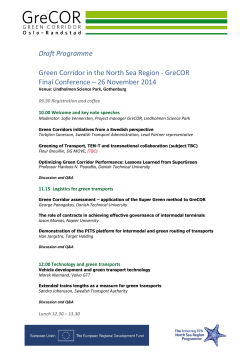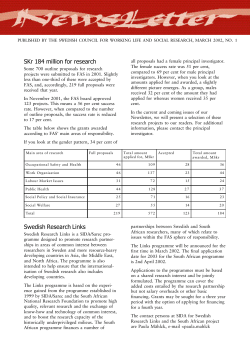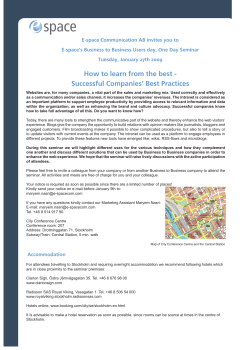
STArTIng A BuSIneSS 1 OperATIng guIDe
Starting a business 1 Mergers and acquisitions – opportunities and process Operating Guide Attractive business opportunities, high transparency and uncomplicated legal and regulatory procedures underpin Sweden’s attractiveness to companies seeking business opportunities. This fact sheet aims to provide a brief overview of the market as well as information on the process for mergers and acquisitions (M&A). Business opportunities Small and medium sized enterprises in Sweden host a rich diversity of advanced technology that presents unique opportunities for international companies seeking to enter the Swedish market, expand their footprint or develop new know-how. Advanced technology Sustained investment in higher education and core research, an array of homegrown research-intensive multinationals and a commitment to top scientific infrastructure have made Sweden a leading supplier of innovative solutions and products to international business. A proven ability to work across disciplines and bridge corporate and academic research environments makes Sweden eminently placed to deliver results. The capacity to develop and integrate complex systems is evident in Sweden’s advanced industrial sectors. Family controlled businesses Family owned or controlled businesses have historically been a pillar of the Swedish enterprise landscape. Demographics are now coming into play as the baby boomers who built many of these companies look to retire. Many of them will be seeking to hand over their businesses to the next generation. But equally, many are contemplating new external owners. Firm framework for M&A activity In many countries, the process of acquiring a company is often seen as complex and time-consuming. This is not the case in Sweden, where a culture of openness and transparency avoids bureaucracy and red tape and facilitates business dynamism. Legal agreements are relatively simple by international standards. Information on a target company’s shares, articles of association, real property or floating charges is easily available in publicly available registers. in brief ▸▸ Opportunities in private and family owned enterprises ▸▸ No discrimination of foreign investors ▸▸ M&A process built on openness and transparency ▸▸ Relatively simple agreements Published in May 2013 Starting a business Low transaction costs Transaction and legal costs are competitive and lower than in many countries. Lawyers and other advisors are typically involved throughout the transaction process. This is standard practice and merely reflects a desire for professional certainty and accuracy. It is not considered a sign of mistrust or implicit conflict. Swedish contracts and agreements are usually conside rably shorter than US or UK equivalents, for example. Business dealings in Sweden are marked by willingness on both sides to achieve consensus, and the managements of target companies are usually helpful during transaction processes. Defense measures such as the “white knight”, “golden parachute” or “poison pill” are seen rarely or never in Sweden, while trade unions generally do not oppose or impede transactions. An effective arbitration and courts system provides for rapid settlement of disputes and conflicts. Arbitration is the general route for solving any M&A-related disputes. “We value the competency of Swedish engineers and the consensus-oriented approach to business that Sweden and Japan share, and appreciate the solid and stable economy.” Philip de Wolf, Managing Director, DENSO Sales Sweden Openness and transparency Freedom of information is far-reaching in Sweden. Company financial data is readily available in public registers and is easy to access. For instance, all companies must submit detailed year-end financial statements to the Swedish Companies Registration Office (Bolagsverket) and this information is freely available on demand. Sweden’s high standards of transparency are also reflected in accounting practices. A robust regulatory framework comprises the regulations of the Swedish Accounting Standards Board (Bokföringsnämnden) and the Institute for the accountancy profession in Sweden (FAR). All listed Swedish companies are also required to apply the International Financial Reporting Standards (IFRS). Together, these frameworks create a high degree of transparency and certainty in financial reporting, making financial statements easy to read and unlikely to conceal off-balancesheet items and other invisibles. 2 Legal requirements Sweden has no rules that discriminate foreign investors. Shareholders may reside in any country. However, the managing director and at least half of the board members of the aquired Swedish company, must be resident in the EEA. For private M&A, no specific regulations exist regarding share or asset purchases other than general contract law and the Companies Act. For businesses that require specific licenses, for example financial companies, the owner must follow certain regulations regarding ownership assessments etc. Competition rules must also be complied with and Swedish regulators may intervene if a merger is seen as impeding effective competition in the Swedish market. Public M&A is regulated by the Stock Market (Takeover Bids) Act, the Securities Market Act and the Companies Act. Rules of the market place where the target company’s shares are listed also apply, for example the OMX Nordic Exchange Stockholm Rules Concerning Public Takeover Bids in the Stock Market as well as rules issued by the Financial Supervisory Authority. The regulations concern, for example, notification obligations of shareholders which acquire or dispose of shares. Acquiring a company or its operations One way to purchase a company is to take over the business operations, including assets and liabilities. Known as “assets and liabilities business”, this involves buying the business’s assets and the right to run the enterprise. This may include everything from equipment and stock to clientele and agreements entered into. Payment is normally partly made by assuming the debts of the business and other obligations connected to the assets. If the buyer instead purchases all shares and participation rights in a company, this includes ownership of the entire business, with its assets, liabilities, agreements concluded, name, and corporate identity number. Price and other terms and conditions of purchase are negotiated with the owner. The company continues to exist and be liable for agreements and obligations entered into, regardless of the ownership change. For this reason, it is important to examine the company carefully before completing the acquisition. Starting a business 3 The process for M&A in Sweden – an example Acquiring a limited liability company (aktiebolag) involves a multi-step process that starts with strategic evaluation, preliminary analysis and feasibility study and ends with due diligence and completion of the deal. A typical process might take 8–10 months from initial strategic evaluation of multiple acquisition targets to final completion, or around 6 months from first approach. The various steps are described below. 1. Analysis of company and buyer Initial evaluation involves detailed analysis of the target company or companies. Potential synergies, restructuring needs and intrinsic risks and potential problems are assessed at this stage. Capital and equity structures are also reviewed, along with any excluded assets and loss carry forwards in the target company. At this point the client and advisor sign an engagement letter outlining the scope and terms of the assignment. 2. Analysis of pricing mechanism and deal structure The primary considerations here are whether the acquisition will be financed by debt or equity or a combination of the two, and identification of the pricing mechanism and terms and conditions of purchase and sale. 3. Analysis of share data Swedish limited liabilities companies fall within one of two categories depending on how their shares and dividends are organized. “VPC companies” (avstämningsbolag) are those whose register of shareholders is held by a central securities depository, in this case Euroclear. These companies are generally, but not always, listed on a stock exchange and do not issue share certificates. Non-VPC companies are known as “coupon companies” (kupongbolag). For unlisted companies, the board of directors is responsible for keeping, maintaining and making available the shareholders’ register. In all cases, the buyer needs access to share data, including information on minority shareholders. 4. Management presentation Management presentations involve the owner and management team, together with the investment banker, inviting the buyer or group of buyers to hear a management presentation highlighting key information. Presentations also allow an opportunity to ask questions to the management. Overview of process and related tasks 1. Analysis of the company and buyer Issues to consider Potential synergies Restructuring needs and risks Capital structure 2. Analysis of pricing mechanism and deal structure Issues to consider Cash or equity Pricing mechanism Terms and conditions 3. Analysis of share data 4. Management presentation Issues to consider Listed or unlisted company Issues to consider Buyer meets owner and management Minority shareholders Determine share certificate status 5. Letter of intent Issues to consider Letter of intent, confidentiality agreement Documents Letter of intent Confidentiality agreement Documents Engagement letter Exclusivity agreement 6. Due diligence 7. Approval 8. Signing 9. Approval 10. Closing Issues to consider Review of public registers Issues to consider Preparation of applications and filings, e.g. to Competition Authority Issues to consider Share transfer agreement Issues to consider Submission of applications and filings, e.g. to Competition Authority and to Financial Supervisory Authority Issues to consider Conditions precedent to share transfer agreement Agreements with Change of control clauses Documents Closing memorandum Annual reports and interim financial statements Documents Due diligence report Share transfer agreement Documents Signing memorandum Payment of purchase price Starting a business 5. Letter of intent The parties may enter into a confidentiality agreement and/or letter of intent to protect sensitive information and to acknowledge that the acquisition is being seriously considered. A letter of intent will specify the final and best price the buyer is willing to pay for the business and explain details of the transaction structure, including the amount of debt and equity needed to secure the transaction. At this point the buyer’s advisors will negotiate with the seller to determine whether the buyer is granted exclusivity, meaning sole entitlement to proceed with the intended acquisition. 6. Due diligence Due diligence involves the buyer’s professional advisors, including lawyers, accountants and consultants, completing an exhaustive evaluation of the target company – a process that includes a review of all financial records plus anything else deemed material to the sale. A review of public registers is standard practice. The seller’s data is summarized in a due diligence report containing the advisers’ conclusions on legal and financial risks relating to the transaction and other matters of interest to the buyer. The due diligence report further constitutes the basis for the pricing of the target company. 7. Official approval Applications, filings and applications for official approvals, such as from the Swedish Competition Authority (Konkurrensverket), the Swedish Financial Supervisory Authority (Finansinspektionen) and Bolagsverket are drawn up. 8. Signing A signing memorandum outlines the documents signed or provided at signing, such as powers of attorney, minutes of board of directors’ meetings, share transfer agreements. Issues relating to timing, power to sign and disclosure schedules are resolved. 9. Official approval Applications, filings and applications for official approvals, such as from Konkurrensverket, Finansinspektionen and Bolagsverket are filled in, signed and submitted. 4 10. Closing Closing involves finalization of the purchase/sale contract and the filing of registration documents with Bolagsverket (in order, for example, to make effective any changes in the company’s board of directors). Preparations are also made for the finalization of pension arrangements, collateral, bank accounts, insurance and settlement of intragroup issues and internal debts. A closing memorandum outlines closing actions to be taken in accordance with the share transfer agreement, such as transfer of the shares and confirmation of receipt of the purchase price. The actual closing is the day when funds are transferred to pay the purchase price and refinance the target company, and all executed documents are delivered. Shares are trans ferred and an escrow agreement is signed, if applicable. Any post-closing actions cover the finalization of, and any adjustment to, the purchase price and fulfilment of any escrow agreement. Useful contacts Government agencies Swedish Companies Registration Office (Bolagsverket) SE-851 81 Sundsvall +46 60 18 40 00 www.bolagsverket.se The Swedish Companies Registration Office is the government agency that registers new companies as well as changes in established companies and receives annual accounts, etc. Swedish Tax Agency (Skatteverket) SE-171 94 Solna 0771 567 567 (from Sweden) +46 8 564 851 60 (from abroad) www.skatteverket.se The Swedish Tax Agency is the government agency for taxation, tax collection and national registration of residents. Further information At www.business-sweden.se ▸▸ Starting a business in Sweden – an introduction ▸▸ Starting a limited liability company ▸▸ Running a business in Sweden – an introduction External experts have reviewed this DOCUMENT. However, the contents should not be viewed as legal or financial advice but only as an overview of current conditions in Sweden. These may change and thereby render descriptions of laws and other frameworks inaccurate. In all individual cases we request that advice always be sought with relevant organizations on specific issues.
© Copyright 2025





















